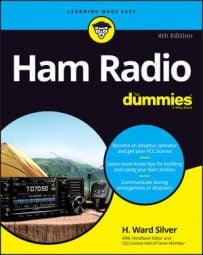About the book author:
H. Ward Silver has experienced a 20-year career as an electrical engineer developing instrumentation and medical electronics. He also spent 8 years in broadcasting, both programming and engineering. In 2000, he turned to teaching and writing as a second career, producing Ham Radios For Dummies in 2004. He supports Seattle University’s Electrical and Computer Engineering Department in laboratory instruction. He is an avid Amateur Radio operator, Extra Class, first licensed in 1972. Each month, his columns and articles can be found in the national ham radio magazine, QST, published by the American Radio Relay League (ARRL). He is the author of the ARRL’s online courses in Antenna Design and Construction, Analog Electronics, and Digital Electronics. When not in front of a computer screen, you will find him working on his mandolin technique and compositions.

